[English] 日本語
 Yorodumi
Yorodumi- EMDB-1373: Architecture of the Dam1 kinetochore ring complex and implication... -
+ Open data
Open data
- Basic information
Basic information
| Entry | Database: EMDB / ID: EMD-1373 | |||||||||
|---|---|---|---|---|---|---|---|---|---|---|
| Title | Architecture of the Dam1 kinetochore ring complex and implications for microtubule-driven assembly and force-coupling mechanisms. | |||||||||
 Map data Map data | This is the single particle reconstruction of the DeltaC Dam1 mutant complex in its dimeric form. | |||||||||
 Sample Sample |
| |||||||||
| Biological species |  | |||||||||
| Method | single particle reconstruction / negative staining / Resolution: 29.0 Å | |||||||||
 Authors Authors | Wang H-W / Ramey VH / Westermann S / Leschziner AE / Welburn JPI / Nakajima Y / Drubin DG / Barnes G / Nogales E | |||||||||
 Citation Citation |  Journal: Nat Struct Mol Biol / Year: 2007 Journal: Nat Struct Mol Biol / Year: 2007Title: Architecture of the Dam1 kinetochore ring complex and implications for microtubule-driven assembly and force-coupling mechanisms. Authors: Hong-Wei Wang / Vincent H Ramey / Stefan Westermann / Andres E Leschziner / Julie P I Welburn / Yuko Nakajima / David G Drubin / Georjana Barnes / Eva Nogales /  Abstract: The Dam1 kinetochore complex is essential for chromosome segregation in budding yeast. This ten-protein complex self-assembles around microtubules, forming ring-like structures that move with ...The Dam1 kinetochore complex is essential for chromosome segregation in budding yeast. This ten-protein complex self-assembles around microtubules, forming ring-like structures that move with depolymerizing microtubule ends, a mechanism with implications for cellular function. Here we used EM-based single-particle and helical analyses to define the architecture of the Dam1 complex at 30-A resolution and the self-assembly mechanism. Ring oligomerization seems to be facilitated by a conformational change upon binding to microtubules, suggesting that the Dam1 ring is not preformed, but self-assembles around kinetochore microtubules. The C terminus of the Dam1p protein, where most of the Aurora kinase Ipl1 phosphorylation sites reside, is in a strategic location to affect oligomerization and interactions with the microtubule. One of Ipl1's roles might be to fine-tune the coupling of the microtubule interaction with the conformational change required for oligomerization, with phosphorylation resulting in ring breakdown. | |||||||||
| History |
|
- Structure visualization
Structure visualization
| Movie |
 Movie viewer Movie viewer |
|---|---|
| Structure viewer | EM map:  SurfView SurfView Molmil Molmil Jmol/JSmol Jmol/JSmol |
| Supplemental images |
- Downloads & links
Downloads & links
-EMDB archive
| Map data |  emd_1373.map.gz emd_1373.map.gz | 7.4 MB |  EMDB map data format EMDB map data format | |
|---|---|---|---|---|
| Header (meta data) |  emd-1373-v30.xml emd-1373-v30.xml emd-1373.xml emd-1373.xml | 9.8 KB 9.8 KB | Display Display |  EMDB header EMDB header |
| Images |  1373.gif 1373.gif | 34.4 KB | ||
| Archive directory |  http://ftp.pdbj.org/pub/emdb/structures/EMD-1373 http://ftp.pdbj.org/pub/emdb/structures/EMD-1373 ftp://ftp.pdbj.org/pub/emdb/structures/EMD-1373 ftp://ftp.pdbj.org/pub/emdb/structures/EMD-1373 | HTTPS FTP |
-Validation report
| Summary document |  emd_1373_validation.pdf.gz emd_1373_validation.pdf.gz | 210.8 KB | Display |  EMDB validaton report EMDB validaton report |
|---|---|---|---|---|
| Full document |  emd_1373_full_validation.pdf.gz emd_1373_full_validation.pdf.gz | 209.9 KB | Display | |
| Data in XML |  emd_1373_validation.xml.gz emd_1373_validation.xml.gz | 4.9 KB | Display | |
| Arichive directory |  https://ftp.pdbj.org/pub/emdb/validation_reports/EMD-1373 https://ftp.pdbj.org/pub/emdb/validation_reports/EMD-1373 ftp://ftp.pdbj.org/pub/emdb/validation_reports/EMD-1373 ftp://ftp.pdbj.org/pub/emdb/validation_reports/EMD-1373 | HTTPS FTP |
-Related structure data
- Links
Links
| EMDB pages |  EMDB (EBI/PDBe) / EMDB (EBI/PDBe) /  EMDataResource EMDataResource |
|---|
- Map
Map
| File |  Download / File: emd_1373.map.gz / Format: CCP4 / Size: 8.2 MB / Type: IMAGE STORED AS FLOATING POINT NUMBER (4 BYTES) Download / File: emd_1373.map.gz / Format: CCP4 / Size: 8.2 MB / Type: IMAGE STORED AS FLOATING POINT NUMBER (4 BYTES) | ||||||||||||||||||||||||||||||||||||||||||||||||||||||||||||||||||||
|---|---|---|---|---|---|---|---|---|---|---|---|---|---|---|---|---|---|---|---|---|---|---|---|---|---|---|---|---|---|---|---|---|---|---|---|---|---|---|---|---|---|---|---|---|---|---|---|---|---|---|---|---|---|---|---|---|---|---|---|---|---|---|---|---|---|---|---|---|---|
| Annotation | This is the single particle reconstruction of the DeltaC Dam1 mutant complex in its dimeric form. | ||||||||||||||||||||||||||||||||||||||||||||||||||||||||||||||||||||
| Projections & slices | Image control
Images are generated by Spider. | ||||||||||||||||||||||||||||||||||||||||||||||||||||||||||||||||||||
| Voxel size | X=Y=Z: 4 Å | ||||||||||||||||||||||||||||||||||||||||||||||||||||||||||||||||||||
| Density |
| ||||||||||||||||||||||||||||||||||||||||||||||||||||||||||||||||||||
| Symmetry | Space group: 1 | ||||||||||||||||||||||||||||||||||||||||||||||||||||||||||||||||||||
| Details | EMDB XML:
CCP4 map header:
| ||||||||||||||||||||||||||||||||||||||||||||||||||||||||||||||||||||
-Supplemental data
- Sample components
Sample components
-Entire : Dam1 DeltC mutant complex
| Entire | Name: Dam1 DeltC mutant complex |
|---|---|
| Components |
|
-Supramolecule #1000: Dam1 DeltC mutant complex
| Supramolecule | Name: Dam1 DeltC mutant complex / type: sample / ID: 1000 Details: The sample was mainly composed of dimers and little percentage of monomers and trimers. Oligomeric state: Dimeric decamer / Number unique components: 1 |
|---|---|
| Molecular weight | Experimental: 200 KDa / Theoretical: 200 KDa |
-Macromolecule #1: Dam1 DeltC mutant complex
| Macromolecule | Name: Dam1 DeltC mutant complex / type: protein_or_peptide / ID: 1 / Number of copies: 2 / Oligomeric state: dimer of decamer / Recombinant expression: Yes |
|---|---|
| Source (natural) | Organism:  |
| Molecular weight | Experimental: 200 KDa / Theoretical: 200 KDa |
| Recombinant expression | Organism:  |
-Experimental details
-Structure determination
| Method | negative staining |
|---|---|
 Processing Processing | single particle reconstruction |
| Aggregation state | particle |
- Sample preparation
Sample preparation
| Concentration | 2 mg/mL |
|---|---|
| Buffer | pH: 6.8 Details: 500 mM NaCl, 20 mM sodium phosphate pH 6.8, 1 mM EDTA |
| Staining | Type: NEGATIVE Details: The complexes were negatively stained with 2% uranyl formate with the sandwich method between two layers of thin carbon film. |
| Grid | Details: 400 mesh copper grid |
| Vitrification | Cryogen name: NONE |
- Electron microscopy
Electron microscopy
| Microscope | FEI TECNAI 12 |
|---|---|
| Alignment procedure | Legacy - Astigmatism: objective lens astigmatism was corrected at 120,000 magnification |
| Details | The micrographs were taken at low dose mode. |
| Image recording | Category: FILM / Film or detector model: KODAK SO-163 FILM / Digitization - Scanner: OTHER / Digitization - Sampling interval: 12.7 µm / Number real images: 200 Details: The micrographs were scanned on a Nikon Super Coolscan 8000 scanner Od range: 1.4 / Bits/pixel: 14 |
| Tilt angle min | 0 |
| Electron beam | Acceleration voltage: 120 kV / Electron source: LAB6 |
| Electron optics | Illumination mode: FLOOD BEAM / Imaging mode: BRIGHT FIELD / Cs: 6.6 mm / Nominal defocus max: 1.5 µm / Nominal defocus min: 0.7 µm / Nominal magnification: 49000 |
| Sample stage | Specimen holder: Eucentric / Specimen holder model: OTHER |
- Image processing
Image processing
| Details | The particles were selected using WEB program manually. |
|---|---|
| Final reconstruction | Applied symmetry - Point group: C1 (asymmetric) / Algorithm: OTHER / Resolution.type: BY AUTHOR / Resolution: 29.0 Å / Resolution method: FSC 0.5 CUT-OFF / Software - Name: IMAGIC, SPIDER / Number images used: 5984 |
| Final angle assignment | Details: SPIDER: theta 90 degrees, phi 90 degrees |
| Final two d classification | Number classes: 50 |
 Movie
Movie Controller
Controller


 UCSF Chimera
UCSF Chimera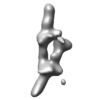



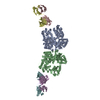
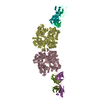
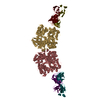
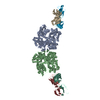
 Z (Sec.)
Z (Sec.) Y (Row.)
Y (Row.) X (Col.)
X (Col.)





















